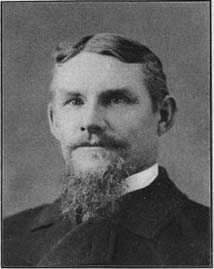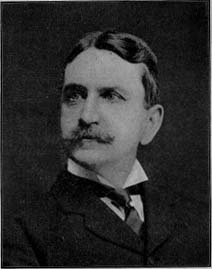|
Sketch of Holyoke by George H. Allyn, page 7 Mr. Ewing and his family were engaged in prayer, Mr. Ewing kneeling before a chair, and when the miscreants inserted the pistol through an open window, and the roar of it almost took the roof off, Mr. E. went headforemost right over the chair. Forestdale cemetery, comprising twenty-four and one-half acres of land, was dedicated in 1862. Before this the only cemetery, aside from the old one at Baptist Village, was one on Northampton street, about two hundred and fifty feet north of Hampden street, which had been used by the more northerly of the Northampton street vicinity families, probably as far back as 1835. About 1885 the use of this cemetery was discontinued, and the remains removed to Forestdale.

D.O. Judd.
Holyoke had no inherited ancestral wealth, but rarely could there be found a stronger group of virile citizens than flourished in the late 60's and early 70's. Their courage and foresight were unfailing and unerring. C.O. Carpenter had returned from naval service and began medical practice, and soon Drs. Blodgett, Humeston, and Tuttle came on. But of the "law wolves" (to use Alfred Henry Lewis' expression), we had only Messrs. Pearsons, Underwood, E.W. Chapin, and Judge Buckland until well into the 70s. Of course George Stearns and Charley Knapp of Chicopee were sometimes consulted. C.W. Ranlet had become president of the Hadley Falls National bank, and R.B. Johnson of the Holyoke Savings bank. C. Fayette Smith had entered the employ of the Hadley Falls bank, and of the bank employes era Only H. P. Terry, with his record of forty years faithful service, and Mr. Smith, who is still in harness, remain to recall it. And in fact of the citizens prominent in those days only James H. Newton, Daniel O'Connell, Dwight H. Ives, J. F. and J. A. Sullivan, and possibly a few others survive. J.L.R. Trask had succeeded "Priest" Walker, and the Rev. Mr. Eastman in the Second Congregational church ministry, and for over fifteen years was its eloquent, militant and beloved pastor. Rarely has a clergyman wielded so powerful an influence. He struck straight from the shoulder, and a sermon he preached about 1870, inspired by a murder in a disorderly house, will never be forgotten. by any who heard it. Withal he was delightfully human, free from all nasal cant, or melancholy dissertations. He dearly loved a good horse, and when riding up from Springfield one sweltering day with Deacon Anderson Allyn he realized that the deacon was no race-track driver. The deacon took off his hat, wiped his streaming face, and remarked: "It's terribly hot, Mr. Trask." "Yes," burst out the irate minister, "it's hot most anywhere standing still." In 1865 a corporation comprising Messrs. Stewart, Chase, and Stephen Holman, of Holyoke, and Deacon Alonzo Bardwell of South Hadley Falls, were given a charter as the Holyoke and South Hadley Falls Bridge Company with a capital of $100,000. R.O. Dwight Esq., asserts that the two Water Power Company members of the board were obsessed with the idea that Holyoke should be shut in the style of the ancient Chinese wall, and delayed the building of the bridge until, in 1868, Deacon Bardwell died, "a bitterly disappointed man." Meanwhile (writes Mr. Dwight) travel from the eastern towns to the hustling factory town had far outgrown ferry accommodations. Sometimes, especially in the winter, there would be fifty, sixty, even eighty, two-horse teams patiently waiting a chance to cross to Holyoke, with an equal number waiting to regain the South Hadley side. When the charter had but six months to run, Mr. Lyman, who, in 1864, had bought out H.L. Burt, and became sole editor of the Transcript, R.B. Johnson, of the Holyoke Savings bank, and A.L. Shumway, then the leading dry goods merchant of the town, accompanied by R.0. Dwight, visited the officials of the Carew, Hampshire, and Glasgow Manufacturing Companies, and, as a result of their support, surveys and plans for a bridge were made by Stockwell Bettes, a civil engineer of Springfield.
 George N. Tyler.
The necessary agitation followed, and in 1870 a petition went to the Legislature, signed by 1,500 citizens of Holyoke, South Hadley, Granby, Belchertown, and the other eastern towns. Deacon Edwin Chase, who had served a term in the Senate, took charge of the bill, and Messrs. Shumway and Dwight also did some lobbying. When the committee from the Legislature came to inspect the site a roaring flood had swept away their ferryboat, and all the visitors could do was to wave their hands at the crows assembled on the South Hadley side. The committee promptly recommended the bill, and it was passed in 1871, the commissioners of Hampden and Hampshire counties being empowered to build it. At one time the idea was projected of starting it at the Carew street mill, and running it across to High street, but the popular sentiment determined its present location. The bridge was 1,600 feet long and twenty-seven feet wide, and cost $165,000. It wasn't opened for travel till 1872. The original bridge was shaky, and no team was allowed to go faster than a walk. This didn't obtain, however when the Granby and South Hadley milkmen crossed about 3 o'clock in the morning, and about once a year officers would be stationed there at 2 o'clock in the morning, and the police court at 9 a.m. would resemble a dairy convention. About 1889, the necessity of a new bridge became manifest, but some South Hadleyites objected by reason of their town's proportion of the costs. One citizen is said to have gone to Boston to see a former official of the company which built the first bridge to get data on its strength and solidity. 'Tis said the official threw up his hands in merriment. "Why," said he, "there wasn't an honest thing about that bridge except Delaney's piers." In truth, back in the late 60's, John Delaney was already getting a reputation for sound work which gave him most of the Water Power Company's masonry construction, and eventually made him wealthy. The democracy of work was beginning to be felt, and already the Irish citizens were beginning to feel their status as Holyokers. One of the best town meeting speakers among them was John C. Doran, now watchman at the Whiting Street reservoir. John could talk fluently and forcefully on any subject, and was ready to. It is related that in 1870 he happened to be in Easthampton and noticed a meeting going on, which proved to be the annual town meeting. John went in and quickly picked up the thread of the discourse, which related to the building 0£ either a bridge or schoolhouse in some remote part of the town. Mr. Doran arose and in five minutes had the tide turning in favor of the building project. One of the conservatives in opposition approached him, and asked in what part of the town he lived, and how long he had resided there. John informed him he lived up toward the brick yards, but had only moved there a few months back, and while information was being sought he silently melted away, and hit the road to Holyoke. The strong men of the late 60's, with prescient vision, discerned the need of greater railroad facilities, and though the town was only of 10,000 population these men induced it to finance the building of the Holyoke & Westfield railroad. Another compelling motive was that the Connecticut River Railroad Company, having a monopoly of the freight traffic, had become arbitrary. and Holyoke, democratic from inception, chafed under arrogance. J.C. Parsons, Timothy Merrick, George W. Prentiss, and a host of others pushed the matter, and the town was authorized to issue bonds for some $200,000, acquiring 2,265 shares of stock out of the entire issue of 2,600. The road was completed in 1871, and leased to the New Haven & Northampton Company. An excursion train to Northampton ran on the opening day, and most of the prominent Holyokers went down on it. When one considers the magnitude of the undertaking, and the persevering nerve and spirit which carried it through, they have been pardoned for temporary exhilaration. In any event it is said that the only two sober men of the crowd were Deacon Anderson Allyn and Jeremiah F. Sullivan, who (unfortunately or fortunately) had just joined the newly organized St. Jerome's Temperance Society, and was, therefore, stopped from the flowing bowl. The passenger business of the road was only nominal for years, but the freight traffic was sharp from the start, and its growth almost marvelous. It is interesting to know that the Water Power Company, which characteristic thrift, wanted $2,500,000 for the land taken by the railroad--but didn't get it. A small wooden school, a little south of where Ferguson's laundry stands (near the junction of School and Hampden streets), was the first one attended by the writer in 1867. But the same year the present Ewingville school was completed, with Miss Sarah Chapin as the first teacher. She soon married a Mr. Todd, but later returned to teaching, and continued the work until 1900. About 1868 the present Appleton street school was built by Asa Willard. It is said that Mr. Willard's bid on this was very low, and he desired to give up the contract. He was firmly held, however, and grimly said he'd go through with it according to the plans and specifications. He did so, and built it without a chimney, which the architect had forgotten to include. Mr. Willard knew this, but felt that he could be as stiff as anyone. 'Tis said that one can notice the manner in which the beams had to be cut into and resupported in the school today. George R. Chase was the first principal, a good educator, and though of small stature, a keen and remorseless disciplinarian. The writer attended the school in 1870, at the age of eight years, and Mr. Chase looked pretty trim to him. One Wednesday afternoon the usual weekly speaking and composition efforts were held in the hall upstairs. Whiting Bradley Street, favorite nephew of Whiting Street, a tall, gangling red-headed fellow of sixteen, was in the principal's grade. A good-hearted fellow, but chuck full of mischief, he had a pal named Homer Herrick, who was a fiend incarnate for dare-devilism. Herrick had dug up somewhere a touching ballad, the theme hinging upon the remonstrance of a fellow with an erring, dissipated brother, and the refrain ran something like this:
"One eye closed up, and the other coal black, Street, Street, you're drunk." The scholastic glee burst all bounds, the school howled as one, and in the writer's enthusiasm he bounded up a settee, when "Stubby" Chase, fixing him with a cold, gray eye, said: "Allyn, call and see me after school, and possibly I can calm your exultation." It was already calmed, and in mortal terror I waited to go to the office with a diminutive Irish lad named Michael Lavelle, older, but even smaller than myself. While awaiting the flagellation the writer probably looked ghastlier than a corpse, for the warm little heart of "Mickey" Lavelle was stirred with compassion, and he whispered sympathetically: "Don't you be afraid, George, I'll punch him." The exquisite humor of three-foot, ten-year-old "Mickey's" thrashing the wiry principal restored the writer's equanimity, and eventually Mr. Chase discharged us without the thrashing.
| Previous Page | Next Page |
| People & Organizations | Allyn's Sketch of Holyoke |
| Selected Advertisments | Churches | Surname Index |
© Laurel O'Donnell 1996 - 2005, all rights reserved
This document may be downloaded for personal non-commercial use only and should not be reproduced or distributed without permission. |